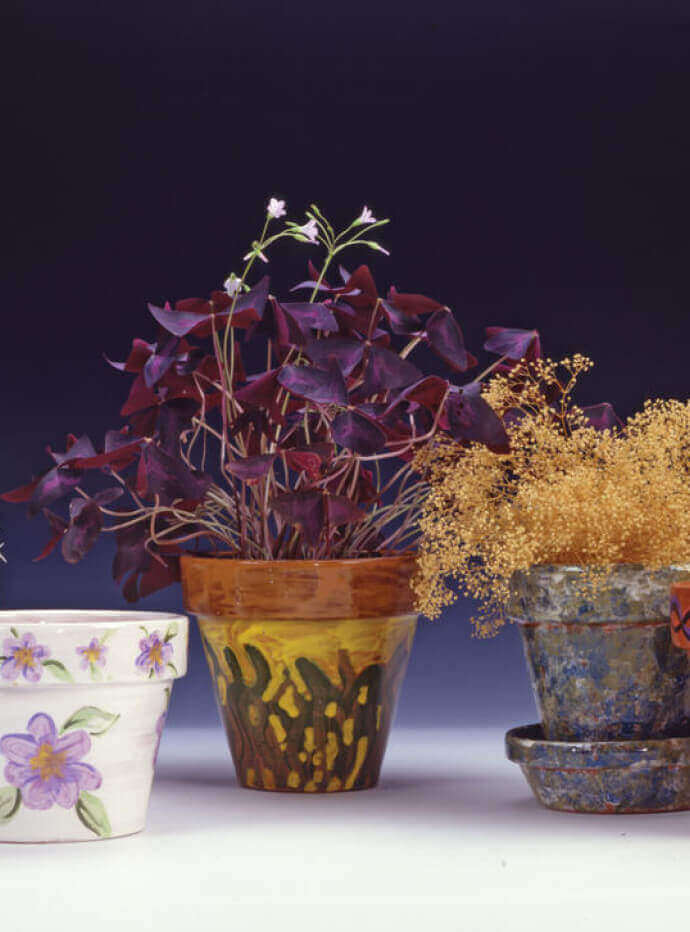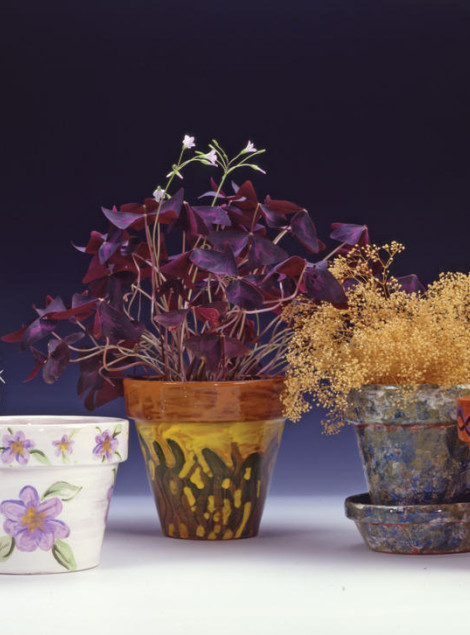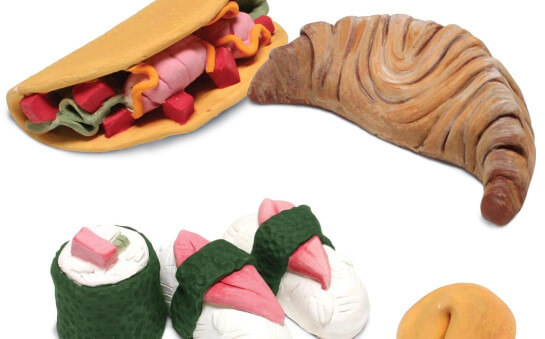A Passion for Pots

Students of any age will enjoy and benefit from the experience of glaze decorating commercially-made terra cotta flower pots. With the flower pots as their canvas, students can experiment and create to the limits of their imaginations and their creativity. The history of functional ceramics goes back to earliest man, and glaze decoration dates back to the Egyptians in 3000 B.C. Over the centuries, in an effort to balance art and craft, functional and decorative, ceramic artists have discovered that glazes and underglazes, when properly formulated, can be painted onto a clay surface with the same great precision and offer the same unlimited potential for elaborate color effects as oil paints and acrylics offer the painter. The elaborate designs and scenes found on pottery created in Spain and Italy during the Renaissance and Baroque periods known as majolica ware are among the best examples of the complex imagery and patterning that can be created on a clay surface.

Background and Preparation
The art teacher should introduce an historical overview of crafts and decorative arts, focusing on ceramics’ rich tradition for complex, stylized imagery. Examples of all types of functional pottery should be shown, from ancient to contemporary, from earthenware to porcelain, from handmade to manufactured. Various vessel forms should also be shown. A special emphasis should be put on majolica ware and how this technique, developed in the Middle Ages and refined in the Renaissance, is still being explored by contemporary ceramic artists.
Talk to students about the intricacies of working in the round. Discuss color theory and how it applies to glazes and glaze combinations, positive and negative space, and elements of design.
For students without previous ceramic experience, provide them with a brief explanation of the equipment, materials, process, and techniques employed when working with clay and glazes.
Create several decorated terra cotta pots, showing a variety of techniques, as examples for your students.
Prefire Pots
Purchase an appropriate quantity of ready-made, bisque-fired terra cotta pots from a garden supply store. Be sure the pots you use have no cracks or chips. 7” or 8” flower pots are a good size because they provide a large enough surface on which to work. However, terra cotta flower pots are available in a variety of sizes, and any size can be used.
The pots should be fired once to cone 04 before decorating. This will thoroughly clean the surface of any oils or grease. The preliminary firing also makes the pots more vitreous.
Underglaze Method
One suggested method for decorating: Paint and draw with liquid underglazes, Velvets, underglaze crayons, and underglaze pencils on the bisque pot. Fire a second time in kiln to cone 04. Glaze with three coats of a clear, low fire glaze and fire a third time to cone 04. Be sure the glaze is applied to the inside of the pot only as far down as the lip (approximately one inch). This creates a more finished, professional appearance, but does not destroy the necessary porosity of the flower pot.
Majolica Method
Glaze bisque pot with three or four coats of Teachers Choice / Teachers Palette Snow (white gloss glaze). Once again, be sure the glaze is applied to the inside of the pot only as far down as the lip. Do not fire the pot at this point. Paint and draw designs on the unfired glazed pot with Teachers Choice / Teachers Palette Glazes to create a majolica effect. Now fire pot for a second time to cone 04.
Suggestions
Encourage self-expression, allowing students the freedom to create real or abstract scenes or designs. Both geometric and free form designs are very effective on the pots.
Urge students to plan their drawings or designs, making a preliminary on a piece of paper and then sketching the design directly on the pot with a pencil. Pencil marks on the bisque pot will fire away in the second firing.
Be sure students use decorating or banding wheels. This allows the student to work on all sides of the flower pot without having to touch it constantly to move it, avoiding smeared glazes and oily fingerprints.
If students are creating designs and not scenes, suggest that they place the pots upside down on the decorating wheel. An upside down pot with a wide bottom/small top slant is sturdier and easier to decorate than the small bottom/wide top slant of an upright pot.
For students unsure of their artistic abilities, sponge painting on flower pots makes very colorful and creative designs. Liquid underglazes and Velvets create true colors and do not mix once applied properly. Starting with darker colors first, apply glaze with a clean, damp sponge, thoroughly covering the outside of the pot with the first color. Allow each coat to dry completely before applying a second color.
Firing
Do not underfire the glazes. Low fire lead free glazes require firing to a high cone 05 to cone 04 to insure the maturity of the glazes. Be sure that no glaze gets on the bottom of the pots. Glaze on the bottom of the pots will cause the pots to adhere to the kiln shelves in firing. If necessary, use stilts.
After Firing: Planting
Glaze decorated flower pots make wonderful gifts for Christmas, Hanukkah, Mother’s Day, or Teacher Recognition Day. As an art club or school fund raiser, glazed decorated flower pots are also ideal. Contact local garden supply stores for donations or discount on a quantity of terra cotta flower pots. Students, working after school, can create a good number of these pots in a relatively short period of time. Arrange for students to set up a booth to sell the pots at your school’s country fair or at an open house or other all-school function for students, faculty, and parents. Or take orders for sales to parents and faculty. Work with the classroom teacher or science teacher to put plants in the pots for a more complete gift or item to sell. Display decorated flower pots filled with beautiful green indoor plants throughout the school — on the secretary’s desk, the principal’s office, teachers’ rooms. Not only will they add a bright and distinctive touch to the school, parents and teachers will develop a passion for pots and plead with you to have the students make more. Examples of decorated terra cotta flower pots are by students at Orchard Country Day School, Indianapolis, Indiana, Gail Emerich, Art Teacher.

